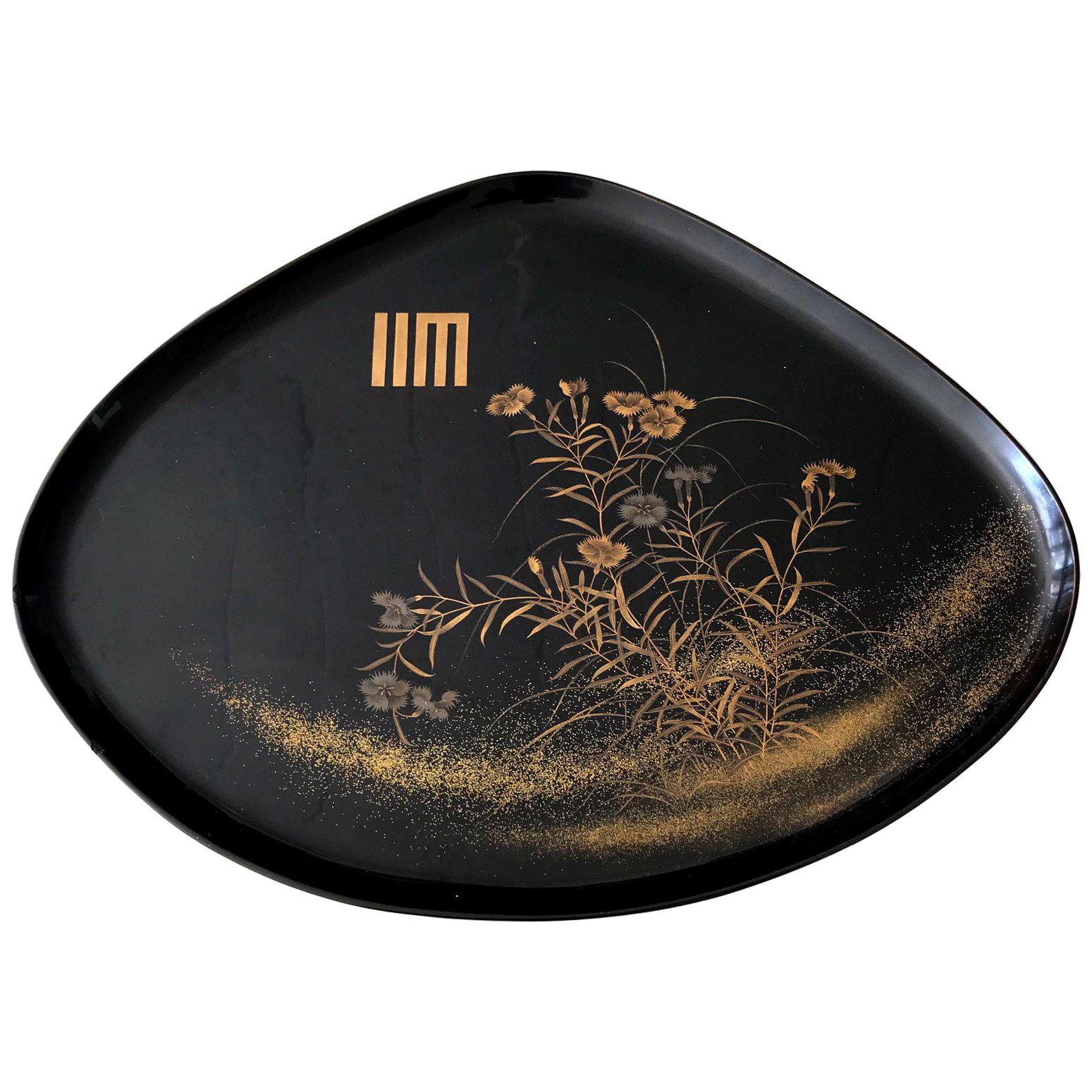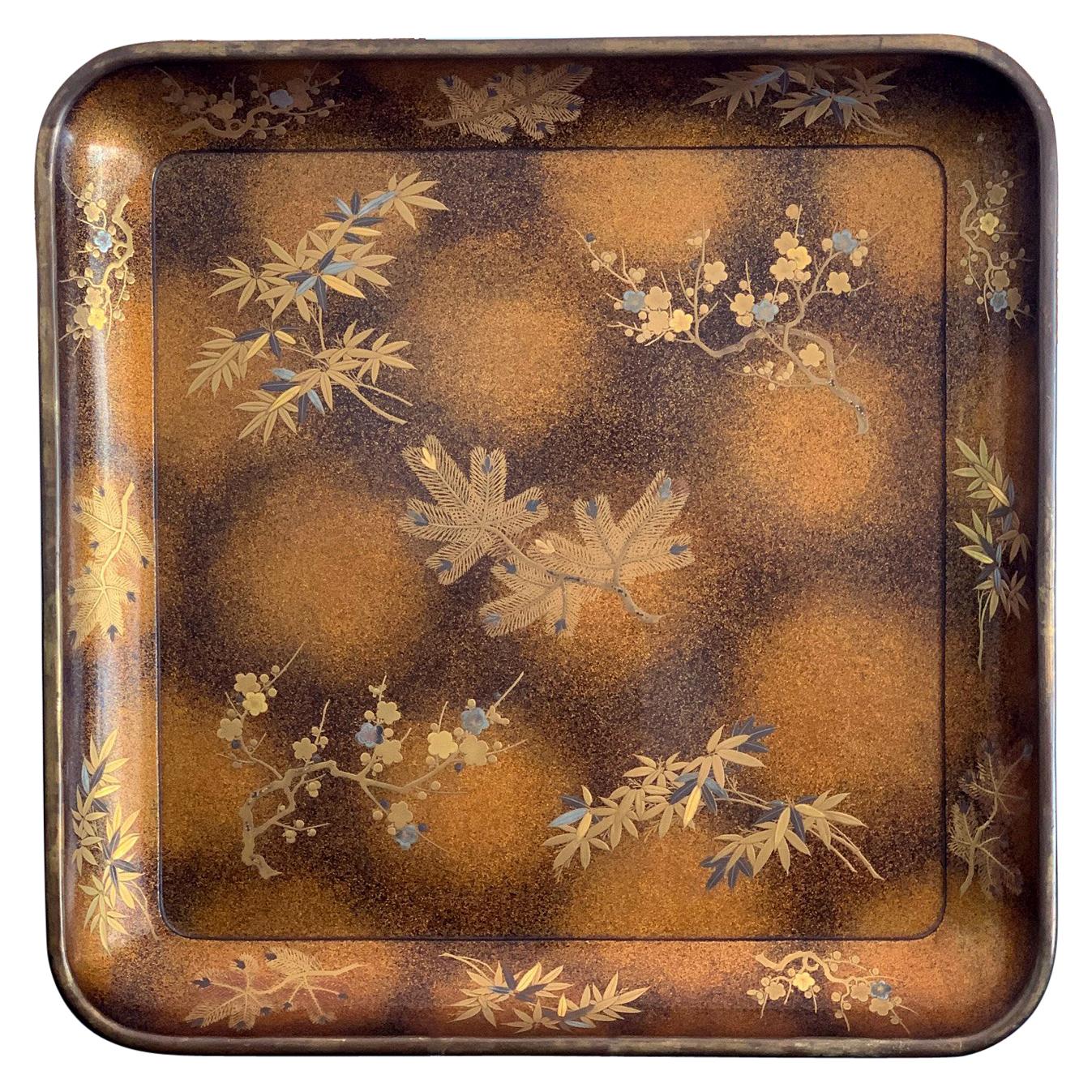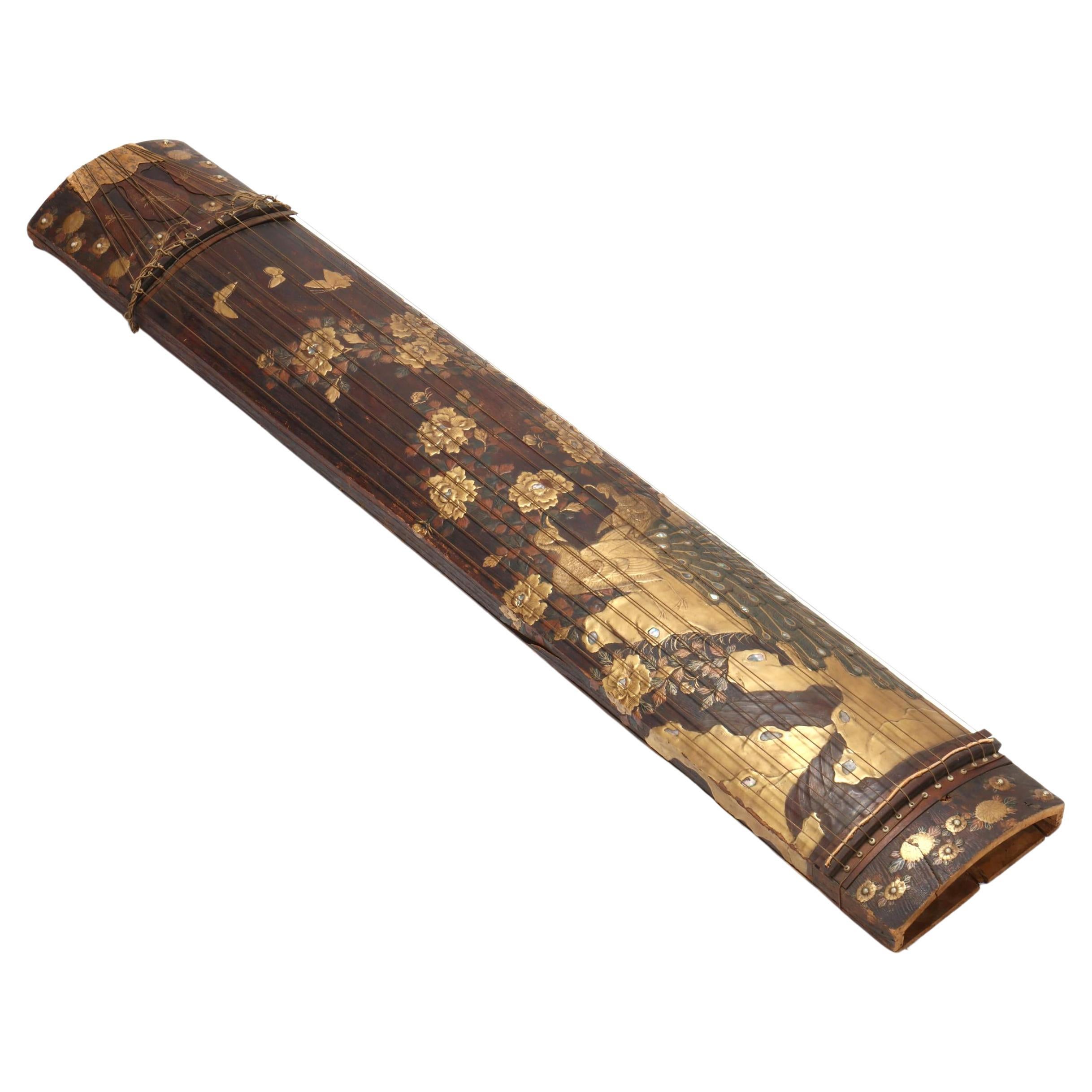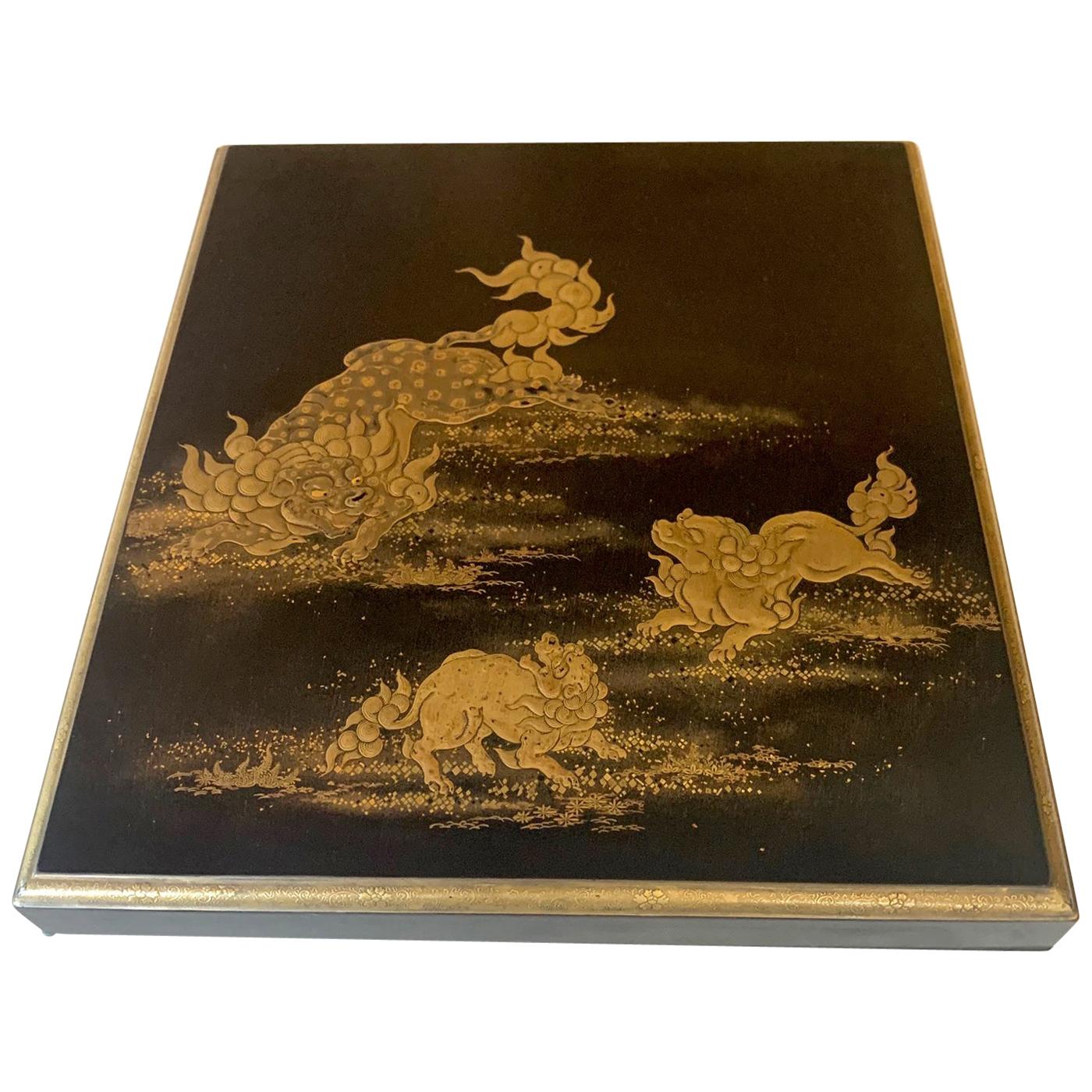Items Similar to 19th Century, Japanese Export Lacquer Tray Maki-e & Mnt Fuji Pagoda Decoration
Want more images or videos?
Request additional images or videos from the seller
1 of 14
19th Century, Japanese Export Lacquer Tray Maki-e & Mnt Fuji Pagoda Decoration
About the Item
Japanese, 19th century.
A very fine quality Japanese lacquer tray. The tray is heavily decorated with a traditional Maki-e gold, black & red surface. Done by an expert craftsman - this round tray appears to depict a pagoda atop Mount. Fuji. The verso is adorned with 3 iron mounts and hand woven cloth support for hanging. Apparently unmarked.
- Dimensions:Height: 1 in (2.54 cm)Diameter: 12.75 in (32.39 cm)
- Materials and Techniques:
- Place of Origin:
- Period:
- Date of Manufacture:19th century
- Condition:Wear consistent with age and use. Surface in overall good condition with some minor wear. Verso has an area of lacquer peeling - does not show through.
- Seller Location:Atlanta, GA
- Reference Number:1stDibs: LU7838237215892
About the Seller
5.0
Platinum Seller
These expertly vetted sellers are 1stDibs' most experienced sellers and are rated highest by our customers.
1stDibs seller since 2022
91 sales on 1stDibs
Typical response time: <1 hour
- ShippingRetrieving quote...Ships From: Randolph, MA
- Return PolicyA return for this item may be initiated within 14 days of delivery.
More From This SellerView All
- 19th Century, Chinese Export Gilt Black Lacquer Melon Form Tea Caddy BoxLocated in Atlanta, GAChinese, 19th century. Chinese lacquer and gilt decorated melon form tea caddy chest or box. The piece is heavily decorated with chinoiserie windows and supported by three giltwood ...Category
Antique Mid-19th Century Chinese Chinese Export Lacquer
MaterialsGiltwood, Lacquer
- Exceptional Chinese Export Gilt Black Lacquer Chinoiserie Decorated Lap DeskLocated in Atlanta, GAChinese export, circa 1820. An exceptional quality and rare form. Featuring figural landscape decorations in gilt to the main black lacquer doors, which open to reveal 13 separated c...Category
Antique Early 19th Century Chinese Chinese Export Lacquer
MaterialsGiltwood, Lacquer
- 19th Century Chinese Export Lacquer Decorated Tea Caddy BoxLocated in Atlanta, GAChinese for the English market, 19th century. A fine quality antique Chinese export tea caddy decorated with beautiful gilding surfaces, a hinged lid which opens to reveal a tooled ...Category
Antique 19th Century English Chinese Export Decorative Boxes
MaterialsPewter
- 19th Century Chinese Export Butterfly & Insect Pith WatercolorLocated in Atlanta, GACanton China, circa 1830. A great and unusual pith watercolor painting of butterflies and insects around a blossoming tree branch. Unmarked.Category
Antique 19th Century Chinese Chinese Export Paintings and Screens
MaterialsSilk, Giltwood, Paper
- 19th Century, Chinese Export Blue & White Armorial Pierced PlatterLocated in Atlanta, GAChinese Export, late 18th to early 19th century. An antique porcelain platter with a blue enameled edge, chestnut basket piercing between ed...Category
Antique Early 19th Century Chinese Chinese Export Ceramics
MaterialsPorcelain
- 19th Century, Chinese Export Famille Jaune Imperial Dragon PlatterLocated in Atlanta, GAChinese, early to mid 19th century. An antique famille jaune platter decorated with 3 imperial dragons chasing the central pearl. A good quality ename...Category
Antique 19th Century Chinese Chinese Export Ceramics
MaterialsPorcelain
You May Also Like
- An Antique Japanese Lacquer Maki-e TrayLocated in Atlanta, GAA fan shape black lacquer tray from Japan circa 1910-30s, late Meiji to early Showa era. Elaborated decorated with a bundle of yomogi blossom in a very fine Maki-e technique using both gold and silver powders. There is a Japanese symbol on the top left, which represents yomogiu, stemming from yomogi (蓬), a wild plant that belongs to the chrysanthemum family and widely grown in Japan. This name yomogui is from a scene in the Tale of Genji...Category
Early 20th Century Japanese Japonisme Lacquer
MaterialsLacquer
- Japanese Maki-e Lacquer Document Box, Edo Period, early 19th Century, JapanLocated in Austin, TXA spectacular Japanese maki-e lacquer lidded box, possibly a writing box, suzuribako, decorated with images of folding fans, ogi, Edo Period, earl...Category
Antique Early 19th Century Japanese Edo Lacquer
MaterialsCoral
- Large Vintage Japanese Maki-e Lacquer Kimono TrayLocated in Atlanta, GAA large square lacquer presentation tray (likely for kimono) predated 1950 of the Showa period. Elaborately decorated with Maki-e that depicts the prunus blossom, bamboo and needle p...Category
Vintage 1940s Japanese Japonisme Lacquer
MaterialsWood, Lacquer
- Japanese Meiji Han Koto with Maki-e Lacquer DecorationLocated in Atlanta, GAA rare Japanese Koto made from carved Paulownia wood and lavishly decorated with lacquer Maki-e circa late 19th century of Meiji Period (1868-1912). The ...Category
Antique Late 19th Century Japanese Japonisme Lacquer
MaterialsWood
- Japanese Maki-e Lacquer Tray Box with Cutout DesignLocated in Atlanta, GAA Japanese lacquer box with lid and an inner tray decorated with Maki-e on a dense nashiji background. The fine box was likely made circa 1920-30s during the Tashio period and likely...Category
Vintage 1920s Japanese Taisho Lacquer
MaterialsWood, Lacquer
- Japanese Lacquer Box with Fine Maki-e Decoration Meiji PeriodLocated in Atlanta, GAA lacquered wood box with lid from Japan circa 19th century Meiji Period. The finely decorated box was used to store paper slips and small documents on the desk. It is overall finished with black lacquer (kuro) with sparse Mura-Nashiji effect outside and on the top surface of the lid, there are three Komainu, (sometimes known as Shishi or Japanese lions) frolicking and forming a circle in lively motion. Komainu are auspicious animals in Japanese cultures in both Shinto and Buddhism tradition. Originally from China, these animals symbolizes guardians to ward off evil spirits. Hiramaki-e was used in combination with carving and combing to render the lions with various surface textures. A gilt border with an slight angle was given to the lid and even the thin band is decorated with miniature floral scrolls. The interior of the box was finished in a dense nashiji. Underneath the lid, a cluster of peonies open lavishly by two gentle mounts. Takamaki-e (high relief) in both gold and silver were...Category
Antique Late 19th Century Japanese Japonisme Lacquer
MaterialsWood, Lacquer
Recently Viewed
View AllMore Ways To Browse
Carved Cinnabar Round Trinket Box
Oriental Mop
Cloisonne Opium Set
Chinese Lacquer Ware
Edo Period Inro
E Gift Cards
Burmese Lacquered Bamboo
Japanese Lacquer Tea Caddy
Burmese Ok
Black Lacquer Box Food Storage
Asian Hat Box
Lacquered Bento Box
Asian Bento Boxes
Japanese Lacquer Comb
Stacking Lunch Box
Tomizo Saratani
African Wand
Antique 18th Century Paving Stones





